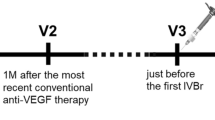Abstract
Background
Factors predictive for response of diabetic macular edema (DME) to intravitreal bevacizumab (IVB) remain unclear. In this study, we assess the predictability of DME response to IVB based on the response to IVB in a previously treated fellow eye and other known pre-injection factors in (DME).
Methods
Retrospective chart review was conducted on 28 patients (56 eyes) with bilateral DME who underwent bilateral IVB therapy. Responses in both eyes were measured by change in central subfield thickness (CSFT) via optic coherence tomography (OCT), and change in visual acuity. Age, lens status, and starting macular thickness were recorded.
Results
We found 21 % of the reduction in CSFT after IVB on OCT in the study eye may be explained by the percentage change in CSFT in the previously treated fellow eye [CI: 0.092–0.716; p-value = 0.0141]. Also, the pre-injection CSFT predicts 14 % of the response to IVB in the same eye [R² = 9.6 %, p-value = 0.018]. When combined in a multi-factorial model, 33 % of the change in CSFT following IVB may be explained by these two factors. Lens status, change in visual acuity, and age were not statistically significant predictors of response.
Conclusions
In DME, the response to IVB in an eye is partially explained by the pre-injection retinal thickness in the same eye and by the response to IVB in the previously treated fellow eye. Lens status, change in visual acuity, and age were not statistically significant predictors of response in this study.



Similar content being viewed by others
References
Centers for Disease Control and Prevention (2011) National diabetes fact sheet: national estimates and general information on diabetes and prediabetes in the United States, 2011. U.S. Department of Health and Human Services, Centers for Disease Control and Prevention, Atlanta
Klein R, Klein BE, Moss SE, Davis MD, DeMets DL (1984) The Wisconsin epidemiologic study of diabetic retinopathy: III. Prevalence and risk of diabetic retinopathy when age at diagnosis is 30 or more years. Arch Ophthalmol 102:527–532
Klein R, Klein BE, Moss SE, Davis MD, DeMets DL (1984) The Wisconsin epidemiologic study of diabetic retinopathy: IV. Diabetic macular edema. Ophthalmology 91:1464–1474
Moss SE, Klein R, Klein BE (1994) Ten-year incidence of visual loss in a diabetic population. Ophthalmology 101(6):1061–1070
Pelosini L, Hull CC, Boyce JF, McHugh D, Stanford MR, Marshall J (2011) Optical coherence tomography may be used to predict visual acuity in patients with macular edema. Invest Ophthalmol Vis Sci 52(5):2741–2748
Roh MI, Kim JH, Kwon OW (2010) Features of optical coherence tomography are predictive of visual outcomes after intravitreal bevacizumab injection for diabetic macular edema. Ophthalmologica 224(6):374–380
Wu PC, Lai CH, Chen CL, Kuo CN (2012) Optical coherence tomographic patterns in diabetic macula edema can predict the effects of intravitreal bevacizumab injection as primary. J Ocul Pharmacol Ther 28(1):59–64
Kim M, Lee P, Kim Y, Yu SY, Kwak HW (2011) Effect of intravitreal bevacizumab based on optical coherence tomography patterns of diabetic macular edema. Ophthalmologica 226(3):138–144
Massin P, Bandello F, Garweg JG, Hansen LL, Harding SP, Larsen M, Mitchell P, Sharp D, Wolf-Schnurrbusch UE, Gekkieva M, Weichselberger A, Wolf S (2010) Safety and efficacy of ranibizumab in diabetic macular edema (RESOLVE study): a 12-month, randomized, controlled, double-masked, multicenter phase II study. Diabetes Care 33(11):2399–2405
Nguyen QD, Brown DM, Marcus DM, Boyer DS, Patel S, Feiner L, Gibson A, Sy J, Rundle AC, Hopkins JJ, Rubio RG, Ehrlich JS (2012) Ranibizumab for diabetic macular edema. Ophthalmology 119(4):789–801
Diabetic Retinopathy Clinical Research Network, Scott IU, Edwards AR, Beck RW, Bressler NM, Chan CK, Elman MJ, Friedman SM, Greven CM, Maturi RK, Pieramici DJ, Shami M, Singerman LJ, Stockdale CR (2007) A phase II randomized clinical trial of intravitreal bevacizumab for diabetic macular edema. Ophthalmology 114(10):1860–1867
Al-Dhibi H, Khan AO (2009) Bilateral response following unilateral intravitreal bevacizumab injection in a child with uveitic cystoid macular edema. J AAPOS 13:400–402
Wu Z, Sadda SR (2008) Effects on the contralateral eye after intravitreal bevacizumab and ranibizumab injections: a case report. Ann Acad Med Singap 37:591–593
Shima C, Sakaguchi H, Gomi F, Kamei M, Ikuno Y, Oshima Y, Sawa M, Tsujikawa M, Kusaka S, Tano Y (2008) Complications in patients after intravitreal injection of bevacizumab. Acta Ophthalmol 86:372–376
Meyer CH, Krohne TU, Holz FG (2012) Concentrations of unbound bevacizumab in the aqueous of untreated fellow eyes after a single intravitreal injection in humans. Acta Ophthalmol 90:68–70
Sawada O, Kawamura H, Kakinoki M, Ohji M (2008) Vascular endothelial growth factor in fellow eyes of eyes injected with intravitreal bevacizumab. Graefes Arch Clin Exp Ophthalmol 246:1379–1381
Avery RL, Pearlman J, Pieramici DJ, Rabena MD, Castellarin AA, Nasir MA, Giust MJ, Wendel R, Patel A (2006) Intravitreal bevacizumab (Avastin) in the treatment of proliferative diabetic retinopathy. Ophthalmology 113:1695–1705
Bakri SJ, Snyder MR, Reid JM, Pulido JS, Singh RJ (2007) Pharmacokinetics of intravitreal bevacizumab (Avastin). Ophthalmology 114:855–859
Conflict of interest
No authors have any financial/conflicting interests/proprietary interest to disclose.
Funding
This study was funded by an unrestricted grant from Research to Prevent Blindness.
Location of research
All research for this report was conducted at Medical College of Wisconsin, Milwaukee, Wisconsin.
Proprietary interests
None of the authors have any disclosures.
The authors have full control of all primary data and agree to allow Graefes Archive for Clinical and Experimental Ophthalmology to review the data upon request.
Author information
Authors and Affiliations
Corresponding author
Rights and permissions
About this article
Cite this article
Karth, P.A., Chang, A. & Wirostko, W. Paired responses to intravitreal bevacizumab in diabetic macular edema: predictors of response in the fellow eye. Graefes Arch Clin Exp Ophthalmol 252, 207–211 (2014). https://doi.org/10.1007/s00417-013-2422-4
Received:
Revised:
Accepted:
Published:
Issue Date:
DOI: https://doi.org/10.1007/s00417-013-2422-4




